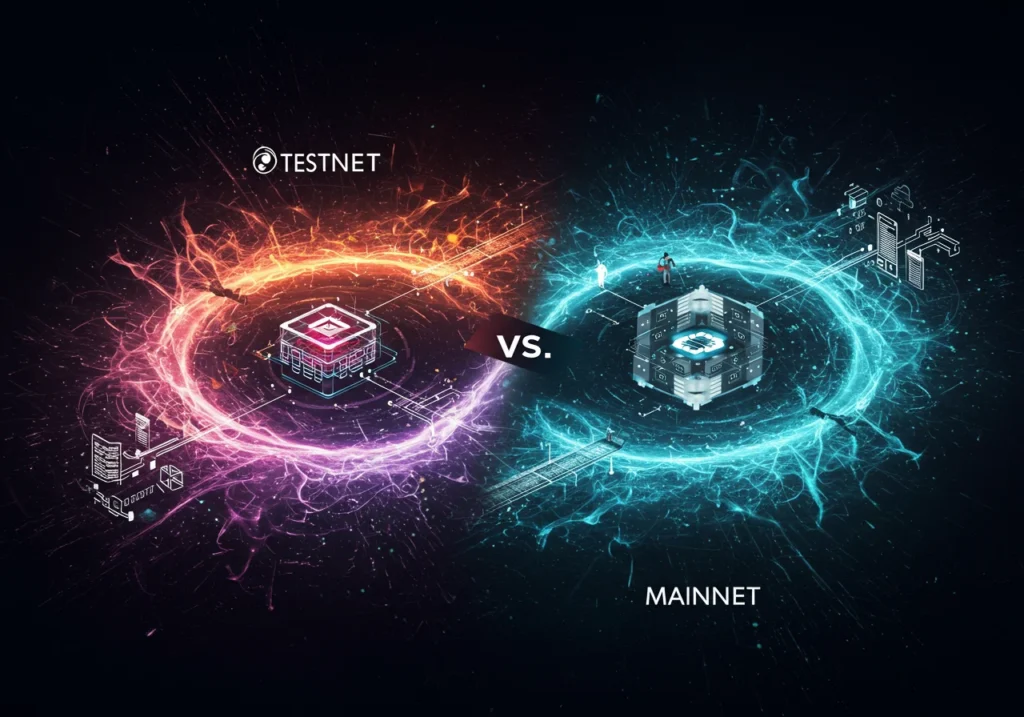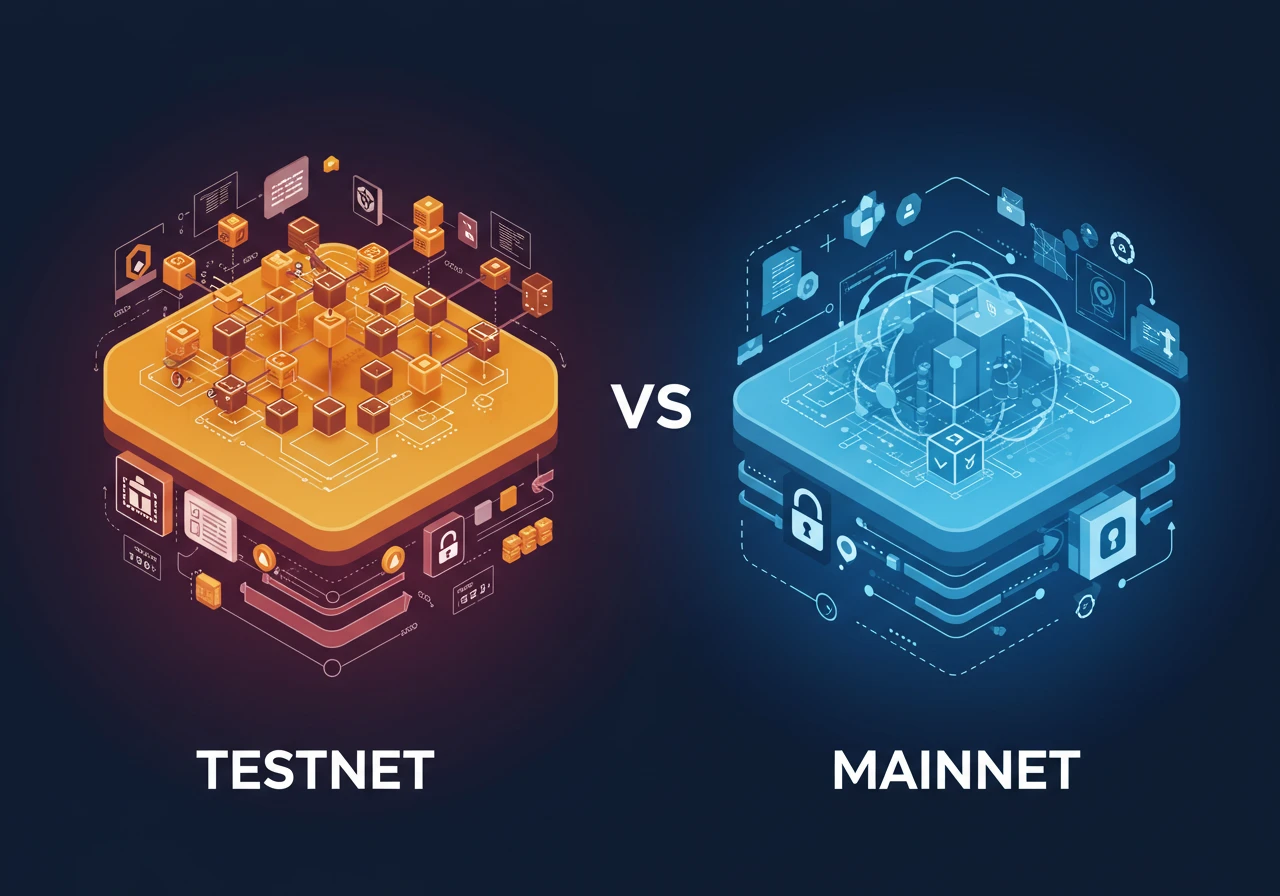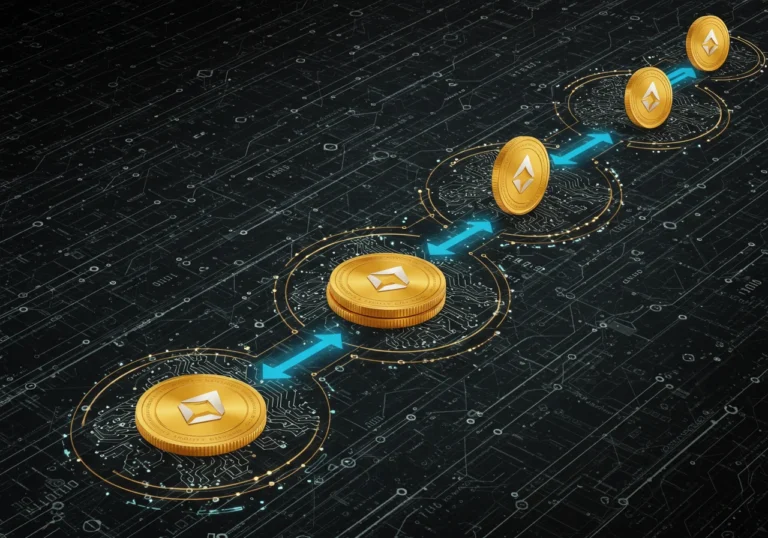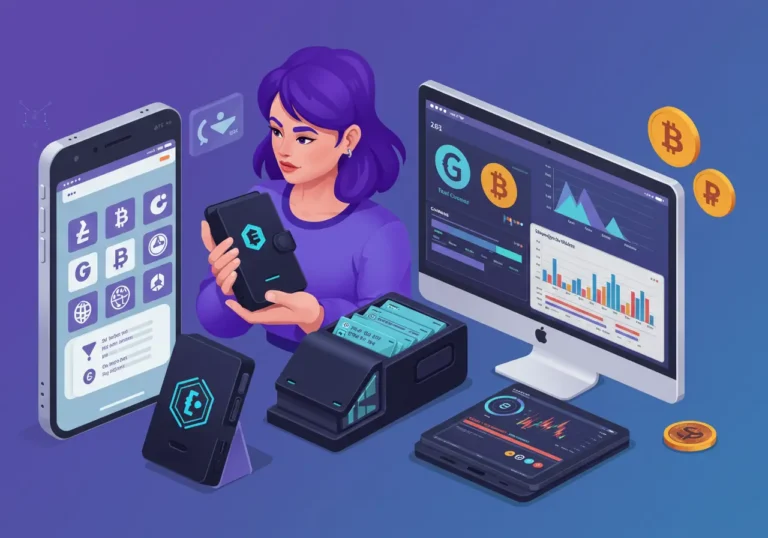What is Testnet and Mainnet? The Key Differences
Testnet and Mainnet are those two worlds. One is for practicing, experimenting, and fixing bugs. The other is where real value moves and real people rely on the network. In the paragraphs that follow, we’ll walk through how they work, why developers use them, and what you should know as a user or builder.
Understanding Testnet and Mainnet

Testnet and Mainnet are two versions of a blockchain network. The mainnet is the main network — the real ledger where actual tokens and transactions have value. The testnet is a separate network that behaves like the mainnet but uses free, valueless tokens. It gives developers and users a safe place to try things out without risking money.
People use testnets to build and test new features, check performance, and find bugs. Think of a testnet like a rehearsal stage before the big show. Once everything looks solid, developers release the code to mainnet where the show goes live.
Why have both?
- Safety: Mistakes on testnet don’t cost money.
- Experimentation: New ideas can be tried without impacting users.
- Performance checks: Teams can measure speed and reliability before launch.
- Education: Beginners learn how to interact with blockchains without risk.
These benefits explain why almost every major blockchain project runs one or more testnets alongside their mainnet.
The main differences: Testnet vs Mainnet differences
When comparing testnet vs mainnet differences, there are a few simple truths:
- Value: Mainnet uses real tokens with market value. Testnet uses tokens that are free and worthless.
- Security: Mainnet has full security and many validators; testnet security is often looser and meant for testing.
- Stability: Mainnet aims for production stability. Testnet expects changes, resets, or forks.
- Access: Anyone can join a testnet to help test; mainnet participation often has higher barriers (staking, fees).
- Data permanence: Transactions on the mainnet are permanent and affect balances. On testnet, data can be reset and is not meant to be permanent.
Knowing these differences helps you pick the right environment when you build or experiment.
Common testnets and how they are used
Different blockchains use different testnets. For example, Ethereum has Goerli and Sepolia testnets. Bitcoin has Testnet3. Other chains like Solana, Polkadot, and Avalanche have their own versions.
Typical testnet uses include:
- Smart contract testing.
- Wallet and UI checks.
- Load testing to see how the network handles many users.
- Security audits and bug bounties.
- Training and demos.
A testnet is not just a copy. It’s a living, changeable sandbox.
How to switch between Testnet and Mainnet
How to switch between Testnet and Mainnet is a common question. The process depends on tools you use, but the concept is simple.
- Choose the network in your wallet or node software. Most wallets show a network dropdown; pick a testnet or mainnet.
- Use the correct RPC or endpoint. Developers often set RPC URLs for each network.
- Obtain test tokens (if testing). Use faucets — services that give small amounts of test tokens for free.
- Confirm you are on the right network before sending value. Double-check the network name and the token type.
If you are a developer running a node, switching may involve changing configuration files or launching a new process with different parameters. If you are a user, your wallet’s network selector does the job.
Practical tip: always verify before you send
Before any transaction, look at your wallet and confirm you are on mainnet if you mean to move real funds. If you are experimenting or teaching, choose testnet and use faucets. A quick glance saves heartache.
Benefits of using Testnet over Mainnet

The benefits of using Testnet over Mainnet are many and important:
- No financial risk: You can make mistakes and learn without financial loss.
- Faster iteration: Developers push frequent updates without affecting users.
- Safer audits: Security teams can stress the system and find weaknesses.
- Community testing: Larger groups can join and spot issues that a small team misses.
- Training and education: Teachers, students, and new users can practice in a realistic environment.
For teams building new features, testnets are essential. A well-tested feature reduces the chance of serious failures on mainnet.
When testnets are reset or upgraded
Testnets are often reset, upgraded, or even retired. That is normal. Testnets are for testing; developers will change their configuration to test migrations, forks, or upgrades. Keep that in mind: data on testnet is less permanent.
Mainnet upgrades, on the other hand, are carefully scheduled and communicated. We’ll look next at release cycles.
Mainnet release schedule updates

Mainnet release schedule updates are formal plans that project teams publish before major changes. These updates tell users:
- Why the change is happening.
- When it will occur (block height, date, or epoch).
- What features or fixes are included.
- Any required actions for users (node upgrades, migrations).
- Risk mitigation steps and rollback plans.
Teams often run the new code on testnet first. They may run multiple testnets to test different parts. Only after confidence is high do they schedule a mainnet release.
If you run a node or rely on a dApp, follow official channels for mainnet release schedule updates so you are prepared.
Testnet performance testing strategies
Good testnet performance testing strategies help teams learn how their systems behave under stress. Here are practical approaches:
- Load testing: Simulate many users making transactions simultaneously to measure throughput and latency.
- Chaos testing: Intentionally disrupt nodes or networks to measure resilience.
- Regression testing: Re-run test suites after code changes to ensure no old bugs reappear.
- Long-duration tests: Run the system under sustained load to look for memory leaks or slow degradation.
- Faucet and tooling checks: Make sure developer tools (faucets, explorers, RPCs) scale with demand.
Using testnet for these tests keeps mainnet safe and preserves user trust.
Bridges and cross-network testing
If your project moves tokens or data between chains, testnets let you exercise bridge logic safely. Cross-chain testing on testnet reveals edge cases and timing issues that are costly on mainnet.
Common mistakes and how to avoid them
Many mistakes are avoidable with care:
- Sending real tokens on testnet — verify network first.
- Using deprecated RPCs — update endpoints before major releases.
- Assuming testnet performance equals mainnet — mainnet may behave differently under real economic incentives.
- Ignoring release notes — always read mainnet release schedule updates.
A checklist before launch reduces problems.
For users: when to use testnet and when mainnet matters
If you are a casual user:
- Use testnet when learning to use wallets, dApps, or when following tutorials.
- Use mainnet when transacting real funds or when you need permanent records.
If you are a developer:
- Use testnet for local development, integration tests, and performance stress.
- Coordinate testnet runs with the community to gather real-world feedback before mainnet releases.
A few real-world examples
- Ethereum: Uses testnets like Goerli for testing smart contracts and upgrades before mainnet merges or protocol changes.
- Bitcoin: Testnet3 allows wallet developers to test transactions without real BTC.
- Polkadot: Has multiple testnets and a staged rollout process to ensure parachains and governance upgrades are safe.
These ecosystems show how serious projects use testnets to build trust before mainnet launches.
Conclusion — why both matter
Testnet and Mainnet play different but connected roles. Testnets let teams and users experiment safely. Mainnet protects real value and demands careful planning for upgrades. Together they make blockchain innovation possible: test, fix, and then launch.
If you build, test early and often. If you use, verify you’re on the right network before you sign transactions. Little steps like these keep your assets safe and keep the wider ecosystem healthy.
Quick recap
- Testnet and Mainnet are separate environments: testnet for practice and mainnet for real value.
- Testnet vs Mainnet differences include token value, security, permanence, and stability.
- How to switch between Testnet and Mainnet: choose network in wallet, set correct RPC, and verify before sending funds.
- Benefits of using Testnet over Mainnet: no financial risk, faster iteration, safer audits, and training.
- Mainnet release schedule updates are published by projects and must be followed closely.
- Testnet performance testing strategies: load testing, chaos testing, regression and long-duration tests.
- Use faucets for test tokens and always double-check the network before transactions.
FAQ
Q: Can testnet tokens be converted to mainnet tokens?
A: No. Testnet tokens have no monetary value and cannot be swapped for mainnet tokens.
Q: Why do testnets sometimes get reset?
A: Testnets are for experiments. Teams reset them to clear data or test migrations and upgrades.
Q: How do I get test tokens?
A: Use a faucet — a service that dispenses small amounts of test tokens to developer addresses.
Q: Are transactions on testnet visible publicly?
A: Yes. Testnet activity is public on testnet explorers, but those transactions have no real monetary value.
Q: Should I run a node on testnet or mainnet?
A: If you are developing or testing, run a node on testnet. For production applications or validators, run mainnet nodes and follow best practices.
Table of Contents

Hello, I’m Edmilson Dias, founder of CoinBringer. I created this platform to guide people through the fast-moving world of cryptocurrency with clarity and safety. With years of research in blockchain and digital security, my goal is to translate complex topics into practical knowledge, offering reliable tutorials, safety insights, and guidance for both newcomers and experienced users.
Discover more from CoinBringer
Subscribe to get the latest posts sent to your email.







